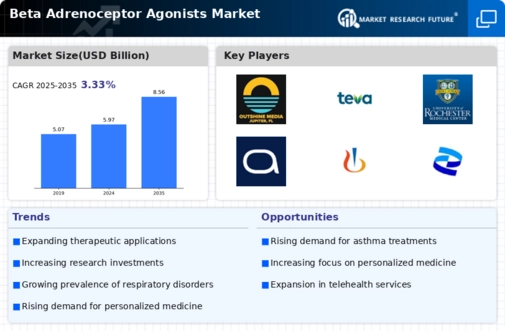Rising Geriatric Population
The increasing geriatric population is poised to be a significant driver for the Beta Adrenoceptor Agonists Market. As individuals age, the prevalence of chronic respiratory diseases tends to rise, necessitating effective management strategies. Data suggests that approximately 80% of older adults have at least one chronic condition, with respiratory issues being among the most common. This demographic shift is likely to escalate the demand for beta agonists, as they are essential in managing symptoms and improving quality of life for elderly patients. Consequently, the Beta Adrenoceptor Agonists Market may experience robust growth, driven by the need to address the unique healthcare challenges faced by the aging population.
Advancements in Pharmaceutical Research
Ongoing advancements in pharmaceutical research and development are significantly influencing the Beta Adrenoceptor Agonists Market. The emergence of novel compounds and formulations, including long-acting beta agonists (LABAs), has expanded treatment options for patients with respiratory diseases. Recent studies indicate that LABAs can provide sustained bronchodilation, enhancing patient adherence to therapy. Furthermore, the integration of biotechnology in drug development is likely to yield more targeted therapies, potentially improving efficacy and safety profiles. As research continues to evolve, the Beta Adrenoceptor Agonists Market may witness an influx of innovative products, catering to the diverse needs of patients and healthcare providers alike.
Growing Awareness of Preventive Healthcare
The increasing awareness of preventive healthcare measures is contributing to the expansion of the Beta Adrenoceptor Agonists Market. Patients and healthcare professionals are becoming more cognizant of the importance of early intervention in managing chronic respiratory conditions. This shift towards preventive care is likely to drive the demand for beta agonists, as they are often prescribed for long-term management of asthma and COPD. Additionally, educational initiatives aimed at promoting respiratory health are expected to enhance patient engagement and adherence to prescribed therapies. Consequently, the Beta Adrenoceptor Agonists Market may benefit from this trend, as more individuals seek effective management strategies for their respiratory conditions.
Regulatory Support for Innovative Therapies
Regulatory bodies are increasingly supporting the development and approval of innovative therapies within the Beta Adrenoceptor Agonists Market. Recent initiatives aimed at expediting the review process for new medications are likely to facilitate quicker access to advanced treatment options for patients. This regulatory environment encourages pharmaceutical companies to invest in research and development, fostering innovation in beta agonist therapies. As a result, the market may see a rise in the introduction of novel formulations and delivery methods, enhancing the overall therapeutic landscape for respiratory disorders. The proactive stance of regulatory agencies could thus play a pivotal role in shaping the future of the Beta Adrenoceptor Agonists Market.
Increasing Prevalence of Respiratory Disorders
The rising incidence of respiratory disorders, such as asthma and chronic obstructive pulmonary disease (COPD), appears to be a primary driver for the Beta Adrenoceptor Agonists Market. According to recent data, asthma affects approximately 300 million individuals worldwide, while COPD impacts around 250 million. This growing patient population necessitates effective therapeutic options, thereby propelling the demand for beta agonists. These medications are integral in managing bronchospasm and improving lung function, which is crucial for patients suffering from these conditions. As healthcare systems increasingly prioritize respiratory health, the Beta Adrenoceptor Agonists Market is likely to experience substantial growth, driven by the need for innovative and effective treatment solutions.


















Leave a Comment